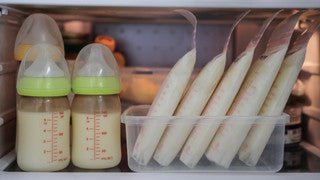Types Of Breastmilk - Foremilk And Hindmilk

Types of Breastmilk - Foremilk and Hindmilk
You may have heard of foremilk and hindmilk and wondered, are these different types of breastmilk? What does this mean?
Foremilk and hindmilk are not different types of breastmilk. Let’s dive deeper into the meaning of foremilk and hindmilk and how knowing the difference can help you in your breastfeeding journey!
Foremilk and hindmilk are the terms used to describe milk at the start (foremilk) and end (hindmilk) of a feeding. They are not different types of milk as you only make one type of milk - the best milk, your breastmilk! : ] The amount of fat in the milk available to baby gradually changes during a nursing session, that is why there are different terms used to describe the milk. It’s important to know about foremilk and hindmilk to help yourself remember to finish feeding on one side before switching to the other breast.
There is no “magic moment” when foremilk becomes hindmilk. As the baby breastfeeds, the increase in fat content is gradual, with the milk becoming fattier and fattier over time as the breast drains more fully.
KellyMom gives a great real world example below to help explain hindmilk and foremilk,
Between feeding sessions, your body is replenishing milk. The fat in the milk sticks together and to the sides of the ducts, while the more watery part of the milk moves down the ducts toward your nipple. There it mixes with any milk leftover from the last session. The fat hangs out at the top of the breast and slowly makes its descent to the nipple.
This means, the more time between milk removal, whether that be nursing or pumping sessions, the lower the fat content of the milk at the beginning of the feeding. The less milk in the breast, the higher the fat content.
Again, I’ll use KellyMom’s real world example to help explain how this works,
Our Key Takeaways
- Foremilk refers to the milk at the start of your feeding session and is higher in volume but lower in fat. However, the fat content of the foremilk varies because it depends on your daily breastfeeding pattern.
- Hindmilk refers to the milk at the end of your feeding. Hindmilk is lower in volume, but higher in fat. However, keep in mind, it is the total milk consumed daily that determines a baby's weight gain, not the amount of hindmilk.
-
Let your baby nurse on one side until they're full. You can offer the other breast, but you don't want to stop their feeding while still nursing. If you do, it can cause the baby to get frustrated, plus you're letting your supply know to only produce for 10 minutes.
- One way to help is if you are nursing the baby on your left breast, you want to make sure you're pumping the right at the same time. Then on your next session, start with the opposite breast from your previous session, so if the baby was nursing on your left last session, make sure the baby is nursing on your right while you are still pumping your left.
As always, you’ve got this mama! Was this helpful? Let us know if The Official Milky Mama Lactation Support Group. It’s filled with Milky Mamas just like you who have come together for support and education during their breastfeeding journey. We’ll see you there, mama!








